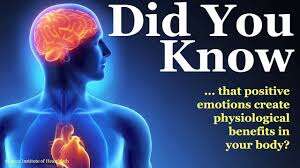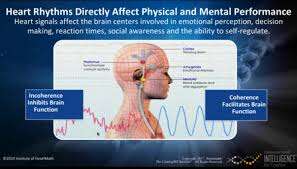Unveiling the Science of Emotions:
The HeartMath Institute conducts extensive research on the intricate relationship between the heart and brain, exploring how they communicate and the impact this has on cognitive and emotional health. Their studies delve into the physiological processes that reveal the heart’s influence on mental capacities and emotional stability. This body of work has led to a better understanding of heart-brain communication and its significance for overall wellness.
By investigating the heart’s role in learning and intelligence, the HeartMath Institute has identified a physiological state linked to optimal functioning and emotional equilibrium. The heart is central to our circulatory system and plays a crucial part in how our emotions and cognition are woven together. These insights have enabled the development of methods and tools to self-regulate emotions and promote psychosocial well-being.
Moreover, HeartMath’s findings underscore the heart’s capacity to act as a source of intuition and to foster a coherent physiological state that can enhance decision-making and personal resilience. Their ongoing research continues to shed light on the heart’s significant role beyond its traditional physiological definition, positioning it as a key component of a holistic approach to health.
The Basics of Heartmath Institute’s Research

The HeartMath Institute’s research focuses on the interconnectivity of the heart and brain, exploring the scientific underpinnings of heart rate variability and the physiological state known as coherence.
Understanding the Heart-Brain Connection
The connection between the heart and brain is a central focus of the HeartMath Institute. They examine the complex, two-way communication system that dictates how emotional and mental states can influence heart rhythms. This field of study, known as neurocardiology, reveals that the heart sends far more signals to the brain than the brain does to the heart, affecting perception, emotion, and cognitive processes.
The Concept of Coherence
HeartMath research emphasizes the state of coherence, where the heart, mind, and emotions are in energetically aligned and balanced. This state is characterized by increased order and harmony in both psychological and physiological processes. Heart coherence is measurable through an electrocardiogram (ECG) and is associated with synchronized heart rhythm patterns, indicating efficient interactions between the parasympathetic and sympathetic branches of the autonomic nervous system.
Heart Rate Variability (HRV) and Its Significance
Heart rate variability is the measure of the moment-to-moment changes in heartbeats. Research by the HeartMath Institute has found that HRV is an important biomarker for heart health, stress, and general well-being. It serves as an indicator of the autonomic nervous system function and an individual’s ability to adapt to stress and environmental demands. The institute’s scientific research correlates various HRV patterns to specific emotional states and thus informs their development of tools. Therefore, tools and techniques for improving emotional self-regulation and overall health.
Emotional and Physical Health Insights
In the realm of cardiology and psychology, the HeartMath Institute provides key insights into how emotional states can significantly impact both physical and mental well-being. Their research underlines the intricate connection between the heart and emotions, suggesting that effective stress management is vital for maintaining overall health.
The Role of Emotions in Cardiac Function

Emotional states have a profound effect on cardiac function. The HeartMath Institute’s studies highlight that positive emotions contribute to smoother heart rhythm patterns, whereas negative emotions can disrupt the cardiac system. This disruption can affect physical well-being and is a key focus in understanding the heart’s role beyond its physical function.
Stress Reduction and Emotional Well-Being
The HeartMath Institute emphasizes the importance of stress reduction techniques for enhancing emotional well-being and fostering resilience. Their work demonstrates how emotional self-management techniques can lead to substantial improvements in emotional balance, mental clarity, and overall health. Reducing stress not only aids in achieving emotional states conducive to well-being but also bolsters an individual’s capacity to navigate life’s challenges with greater ease.
Heartmath Tools and Techniques
HeartMath Institute provides specific methods and technology designed to enhance heart coherence and resilience, aimed at helping individuals manage stress effectively.
Techniques for Achieving Coherence and Resilience
Coherence Techniques: HeartMath Institute emphasizes techniques that foster a state of coherence, where heart, mind, and emotions are in energetic alignment and cooperation. This state is achieved through intentional focus, breathing patterns, and positive emotional re-experiencing. Practices such as Quick Coherence® and Freeze-Frame® Technique are taught for transforming stress and creating a balanced approach to emotional self-regulation.
Resilience Training: Through resilience training, HeartMath aims to build one’s capacity to bounce back from stress. By combining heart-focused practices, one can systematically reduce stress and replace emotional energy with positive feelings, thus enhancing overall well-being.
Technologies for Monitoring Heart Rhythms
emWave Technology: emWave technology is an innovative tool offered by the HeartMath Institute for monitoring heart rhythms. It provides visual feedback on an individual’s heart rate variability (HRV). Therefore, can be an indicator of emotional states and stress levels.
ECG-Based Feedback: The institute leverages electrocardiogram (ECG) technology to track heart coherence levels. Such tools are designed to aid users in visualizing the effects of stress on their heart rhythms and learning how to shift into a more coherent, resilient state through HeartMath methods.
Advanced Heartmath Concepts
The HeartMath Institute researches the multifaceted relationship between the heart and mind. Focusing on the advanced concepts of heart intelligence and its inherent intuitive abilities, as well as neurocardiology. The study of the heart’s intrinsic nervous system—and psychophysiology, which explores how the heart and brain communicate.
Heart Intelligence and Intuition
Heart intelligence refers to a higher level of emotional awareness. Intuitive insight that can lead to profound understanding and wisdom. According to the HeartMath Institute, this concept goes beyond traditional cognitive abilities and taps into the intuitive heart-brain connection. Studies suggest that through coherence—a harmonious state of the heart, mind, and emotions. Individuals can enhance their intuitive abilities and perceive more than what is sensed by the cranial brain alone.
Neurocardiology and Psychophysiology
Neurocardiology examines the heart’s intrinsic nervous system. Recognizing the heart as an intelligent system capable of significant communication with the brain. Psychophysiology studies the dynamic relationship between psychological experiences and physiological responses within the body. The HeartMath Institute’s research in this area illuminates how the heart communicates with the brain and the rest of the body. Therefore, affecting emotional and cognitive functions, and contributes to a deeper understanding of the physiological mechanisms behind stress and emotions.
Impact of Heartmath Institute on Society
The Heartmath Institute’s work has led to meaningful advances in understanding the heart’s role in health and human performance. Its research and programs have found applications across various societal sectors, particularly in healthcare and education.
Heartmath Institute in Healthcare
HeartMath’s resiliency training has been specifically recognized for its positive effects on healthcare providers. Healthcare workers who engaged in this training reported better stress management and increased workplace satisfaction. A study highlighted the benefits where providers used HeartMath techniques during high-stress situations, leading to improved emotional regulation and resilience. For more information on this, refer to The impact of HeartMath resiliency training on health care providers
Educational and Organizational Applications
In educational settings, HeartMath’s methods are employed to enhance learning and connectedness among students and educators. The focus is on the role of the heart in learning with interventions designed to improve concentration and cognitive functions. Their programs have been applied to foster connectedness, impacting young people’s social and emotional development positively. Details can be found in the study The role of the heart in learning and intelligence.
Organizations have also adopted HeartMath’s tools to improve employee performance. Through stress-reduction and self-regulation techniques, employees report higher job satisfaction and performance, directly benefiting the organization’s culture and productivity.
Effects of Emotions on Health: Understanding the Connection https://1111newme.com/2023/08/16/effects-of-emotions-on-health-understanding-the-connection/

One reply on “What the HeartMath Institute Says About the Human Heart:”
I just wanted to take a moment to say how much I appreciate your blog posts. They’re always well-written, informative, and keep me coming back for more. Keep up the great work!